Comprehensive Case Study: African Development Bank Group Analysis
VerifiedAdded on 2023/01/19
|17
|3297
|52
Case Study
AI Summary
This case study analyzes the African Development Bank Group (AfDB), focusing on its role in socioeconomic development across the African continent. The study examines the AfDB's knowledge management strategies, including existing systems for capturing and utilizing knowledge, and evaluates their effectiveness. It explores the challenges the bank faces, such as high poverty and population growth, and discusses various knowledge management techniques and tools, including the MOPAN assessment. The case study details the incentives offered to encourage stakeholders to share knowledge, and the processes AfDB considers for maintaining new systems. It further delves into the approaches utilized to develop the KM strategy and assesses the implementation success. The analysis covers the bank's objectives, including conducting research on developmental challenges, developing efficient knowledge-sharing mechanisms, and leveraging resources. The study also highlights the bank’s stakeholder initiatives, such as professorial endowments and distinguished speaker programs, and concludes with recommendations for enhancing the AfDB's knowledge management practices. The case study is a comprehensive overview of the AfDB's operations and strategies, designed to enhance the bank's voice on the challenges the continent faces and position itself as an advocate.
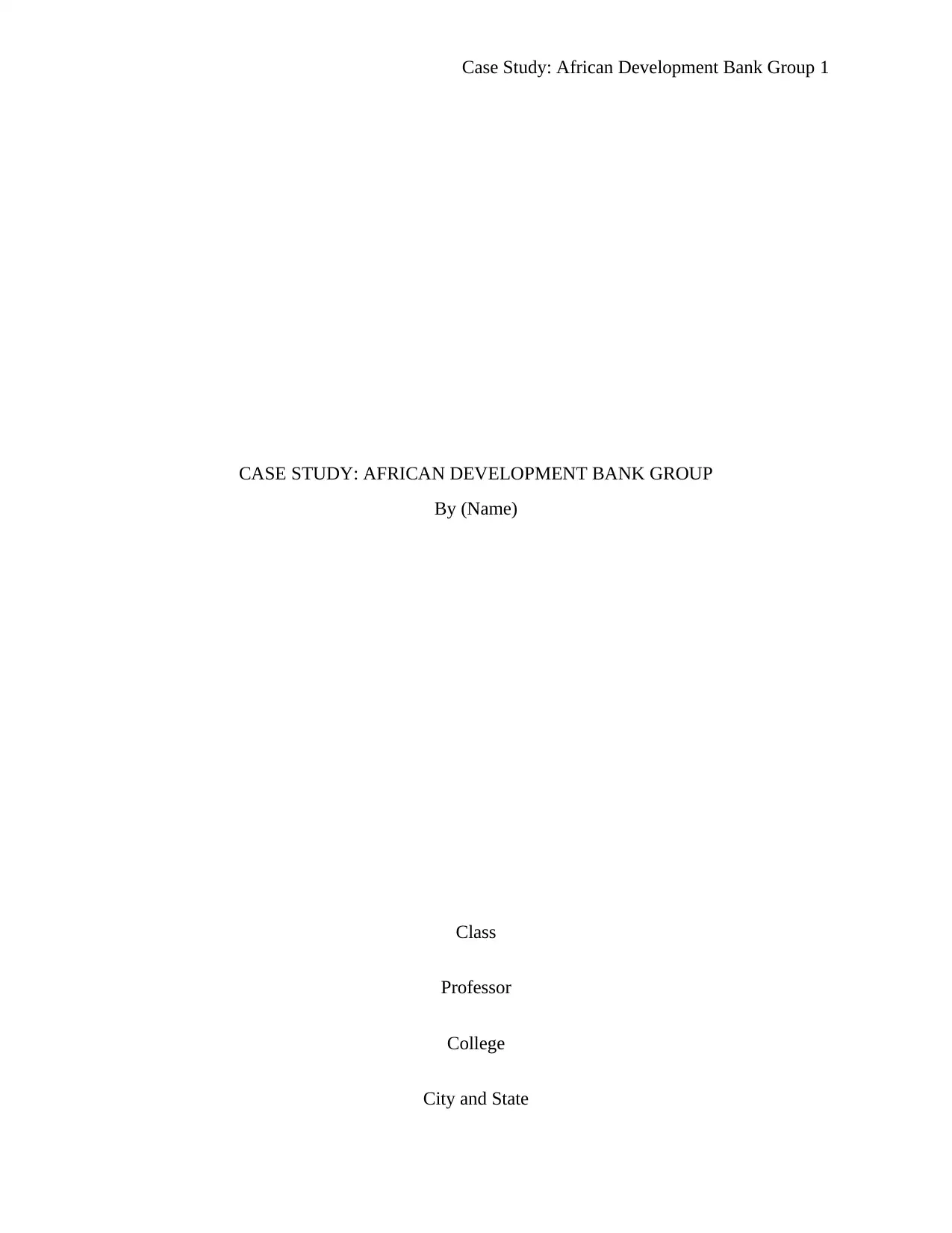
Case Study: African Development Bank Group 1
CASE STUDY: AFRICAN DEVELOPMENT BANK GROUP
By (Name)
Class
Professor
College
City and State
CASE STUDY: AFRICAN DEVELOPMENT BANK GROUP
By (Name)
Class
Professor
College
City and State
Paraphrase This Document
Need a fresh take? Get an instant paraphrase of this document with our AI Paraphraser
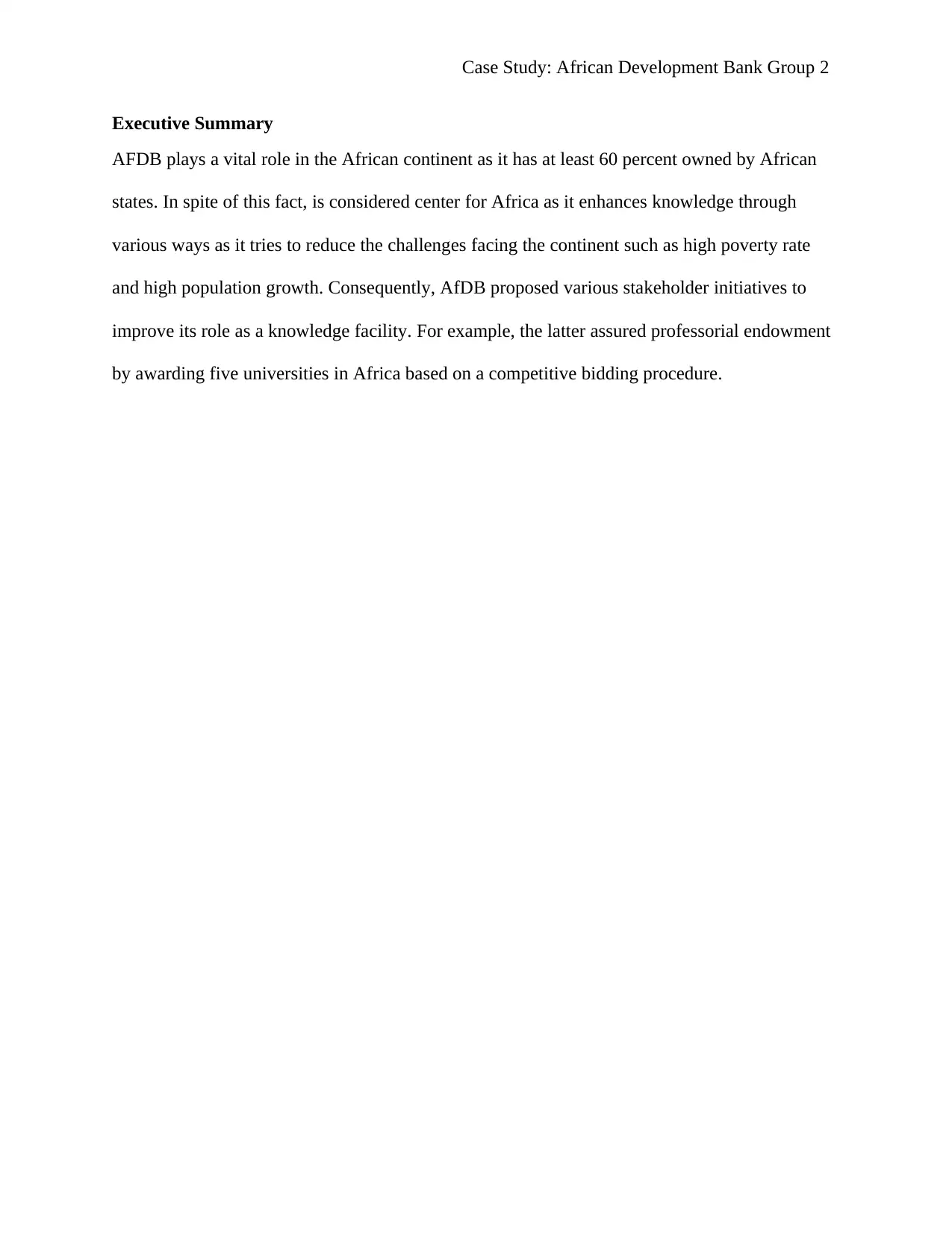
Case Study: African Development Bank Group 2
Executive Summary
AFDB plays a vital role in the African continent as it has at least 60 percent owned by African
states. In spite of this fact, is considered center for Africa as it enhances knowledge through
various ways as it tries to reduce the challenges facing the continent such as high poverty rate
and high population growth. Consequently, AfDB proposed various stakeholder initiatives to
improve its role as a knowledge facility. For example, the latter assured professorial endowment
by awarding five universities in Africa based on a competitive bidding procedure.
Executive Summary
AFDB plays a vital role in the African continent as it has at least 60 percent owned by African
states. In spite of this fact, is considered center for Africa as it enhances knowledge through
various ways as it tries to reduce the challenges facing the continent such as high poverty rate
and high population growth. Consequently, AfDB proposed various stakeholder initiatives to
improve its role as a knowledge facility. For example, the latter assured professorial endowment
by awarding five universities in Africa based on a competitive bidding procedure.

Case Study: African Development Bank Group 3
Table of Content
INTRODUCTION……………………………………………………….………...5
1.1. Introduction…………………………………………………………………....5
1.2. Objectives………………………………………………………………….…5
1.3. Scope……………………………………………………………………….....6
1.4. Problem Statement……………………………………………………………6
ANALYSIS……………………………………………………………………….6
2.1 Existing Arrangements for Capturing and Utilizing Knowledge…………….6
2.2 Existing Knowledge Management Systems and Procedures in AfDB……….7
2.3 Effectiveness of Existing Systems and Procedures…………………………...7
2.4 Ineffective Knowledge Management Strategies in AfDB……………………8
EVALUATION………………………………………………………………..…8
3.1 Barriers Encountered by AfDB in Capturing Knowledge…………………....8
3.2 Options of KM techniques and Tools Used by AfDB……………………..8-10
3.3 Evaluation of the Options on AfDB…………………………………….….10-11
3.4 Incentives Offered to Encourage Stakeholders Share Knowledge………..…11
3.5 The Process of KM that AfDB Considers for Maintaining New Systems…..11-12
DEVELOPMENT………………………………………………………………..12
4.1 Approaches Utilized to Develop KM Strategy………………………………12
4.2 Effective KM Approach……………………………………………………12-13
Table of Content
INTRODUCTION……………………………………………………….………...5
1.1. Introduction…………………………………………………………………....5
1.2. Objectives………………………………………………………………….…5
1.3. Scope……………………………………………………………………….....6
1.4. Problem Statement……………………………………………………………6
ANALYSIS……………………………………………………………………….6
2.1 Existing Arrangements for Capturing and Utilizing Knowledge…………….6
2.2 Existing Knowledge Management Systems and Procedures in AfDB……….7
2.3 Effectiveness of Existing Systems and Procedures…………………………...7
2.4 Ineffective Knowledge Management Strategies in AfDB……………………8
EVALUATION………………………………………………………………..…8
3.1 Barriers Encountered by AfDB in Capturing Knowledge…………………....8
3.2 Options of KM techniques and Tools Used by AfDB……………………..8-10
3.3 Evaluation of the Options on AfDB…………………………………….….10-11
3.4 Incentives Offered to Encourage Stakeholders Share Knowledge………..…11
3.5 The Process of KM that AfDB Considers for Maintaining New Systems…..11-12
DEVELOPMENT………………………………………………………………..12
4.1 Approaches Utilized to Develop KM Strategy………………………………12
4.2 Effective KM Approach……………………………………………………12-13
⊘ This is a preview!⊘
Do you want full access?
Subscribe today to unlock all pages.

Trusted by 1+ million students worldwide
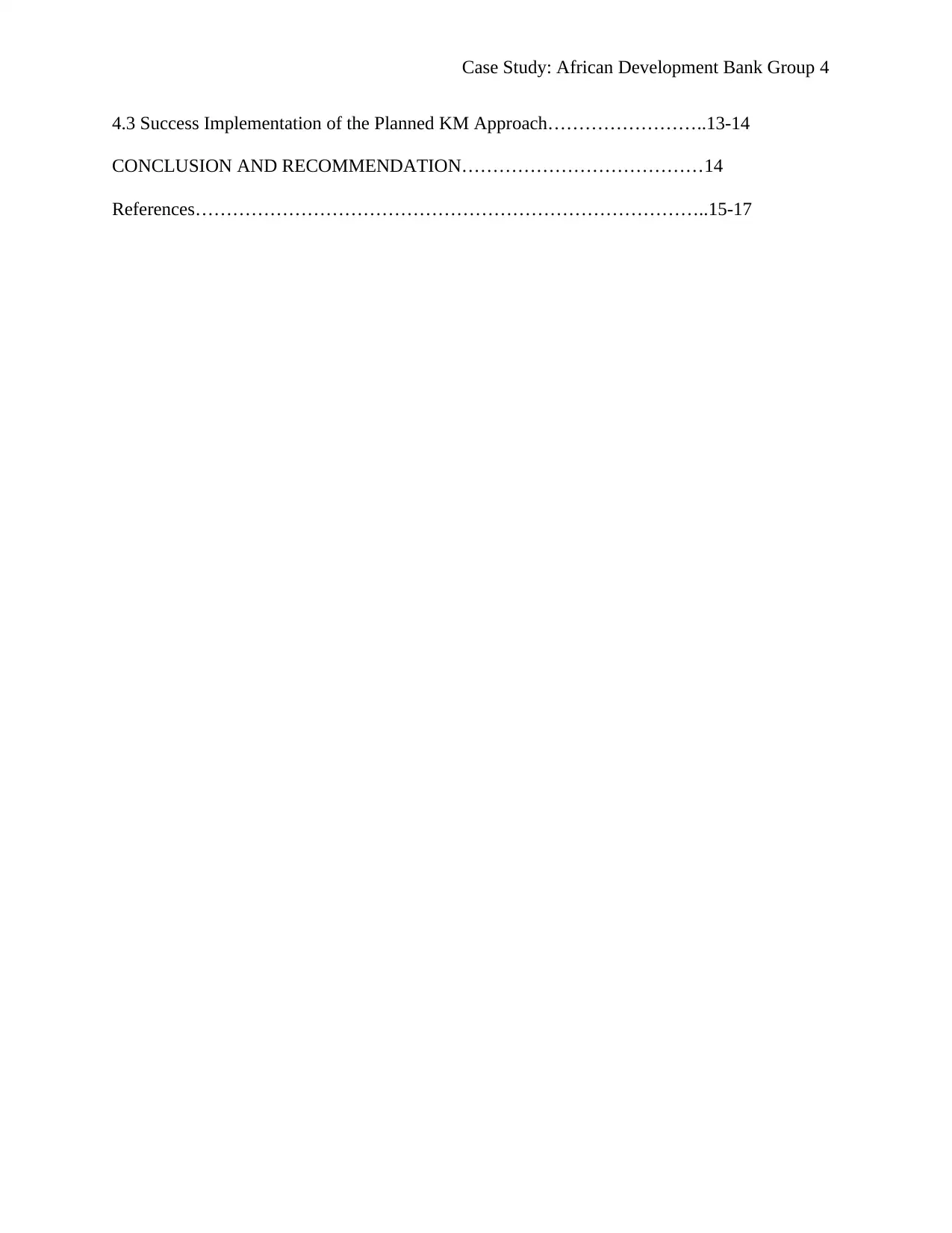
Case Study: African Development Bank Group 4
4.3 Success Implementation of the Planned KM Approach……………………..13-14
CONCLUSION AND RECOMMENDATION…………………………………14
References………………………………………………………………………..15-17
4.3 Success Implementation of the Planned KM Approach……………………..13-14
CONCLUSION AND RECOMMENDATION…………………………………14
References………………………………………………………………………..15-17
Paraphrase This Document
Need a fresh take? Get an instant paraphrase of this document with our AI Paraphraser
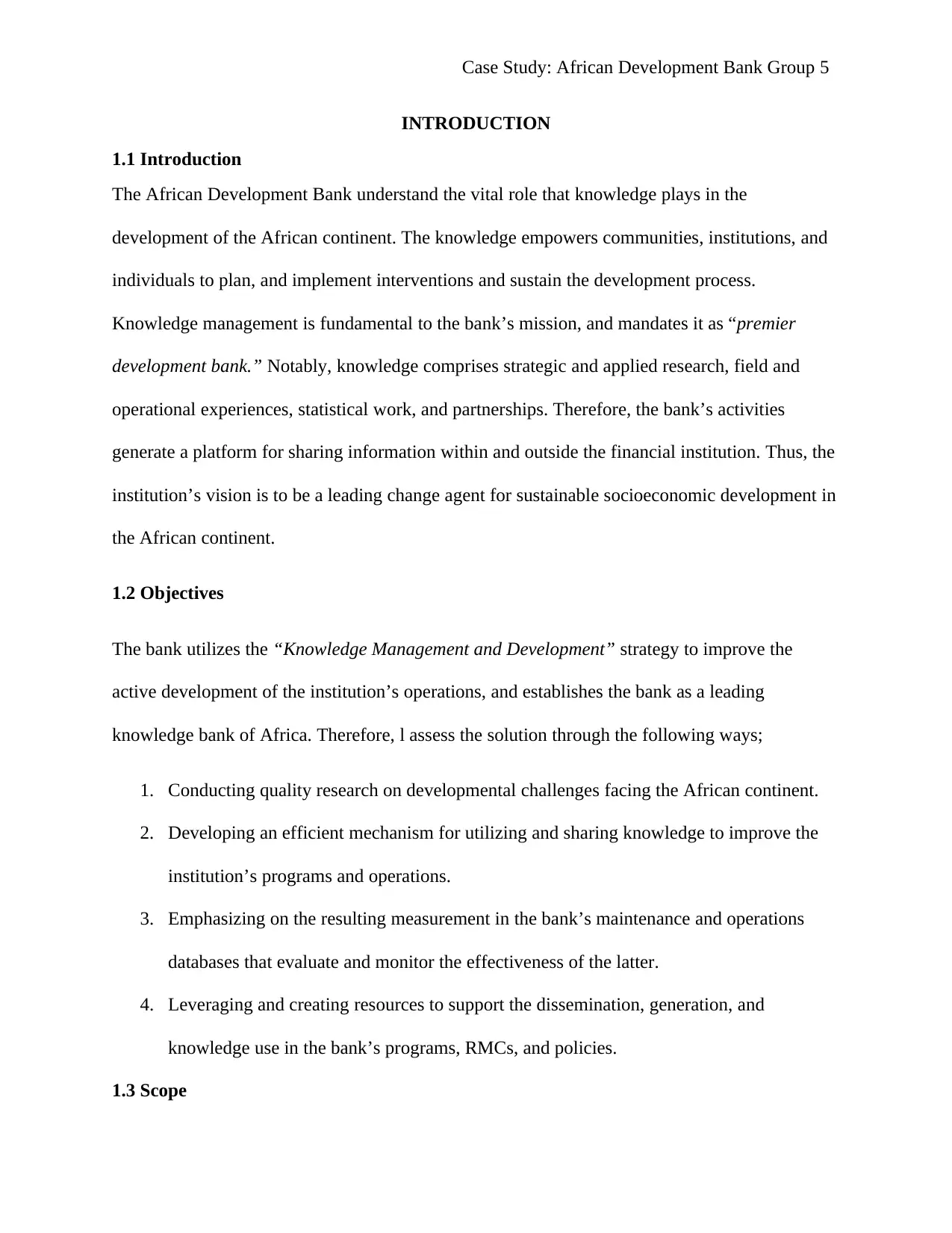
Case Study: African Development Bank Group 5
INTRODUCTION
1.1 Introduction
The African Development Bank understand the vital role that knowledge plays in the
development of the African continent. The knowledge empowers communities, institutions, and
individuals to plan, and implement interventions and sustain the development process.
Knowledge management is fundamental to the bank’s mission, and mandates it as “premier
development bank.” Notably, knowledge comprises strategic and applied research, field and
operational experiences, statistical work, and partnerships. Therefore, the bank’s activities
generate a platform for sharing information within and outside the financial institution. Thus, the
institution’s vision is to be a leading change agent for sustainable socioeconomic development in
the African continent.
1.2 Objectives
The bank utilizes the “Knowledge Management and Development” strategy to improve the
active development of the institution’s operations, and establishes the bank as a leading
knowledge bank of Africa. Therefore, l assess the solution through the following ways;
1. Conducting quality research on developmental challenges facing the African continent.
2. Developing an efficient mechanism for utilizing and sharing knowledge to improve the
institution’s programs and operations.
3. Emphasizing on the resulting measurement in the bank’s maintenance and operations
databases that evaluate and monitor the effectiveness of the latter.
4. Leveraging and creating resources to support the dissemination, generation, and
knowledge use in the bank’s programs, RMCs, and policies.
1.3 Scope
INTRODUCTION
1.1 Introduction
The African Development Bank understand the vital role that knowledge plays in the
development of the African continent. The knowledge empowers communities, institutions, and
individuals to plan, and implement interventions and sustain the development process.
Knowledge management is fundamental to the bank’s mission, and mandates it as “premier
development bank.” Notably, knowledge comprises strategic and applied research, field and
operational experiences, statistical work, and partnerships. Therefore, the bank’s activities
generate a platform for sharing information within and outside the financial institution. Thus, the
institution’s vision is to be a leading change agent for sustainable socioeconomic development in
the African continent.
1.2 Objectives
The bank utilizes the “Knowledge Management and Development” strategy to improve the
active development of the institution’s operations, and establishes the bank as a leading
knowledge bank of Africa. Therefore, l assess the solution through the following ways;
1. Conducting quality research on developmental challenges facing the African continent.
2. Developing an efficient mechanism for utilizing and sharing knowledge to improve the
institution’s programs and operations.
3. Emphasizing on the resulting measurement in the bank’s maintenance and operations
databases that evaluate and monitor the effectiveness of the latter.
4. Leveraging and creating resources to support the dissemination, generation, and
knowledge use in the bank’s programs, RMCs, and policies.
1.3 Scope
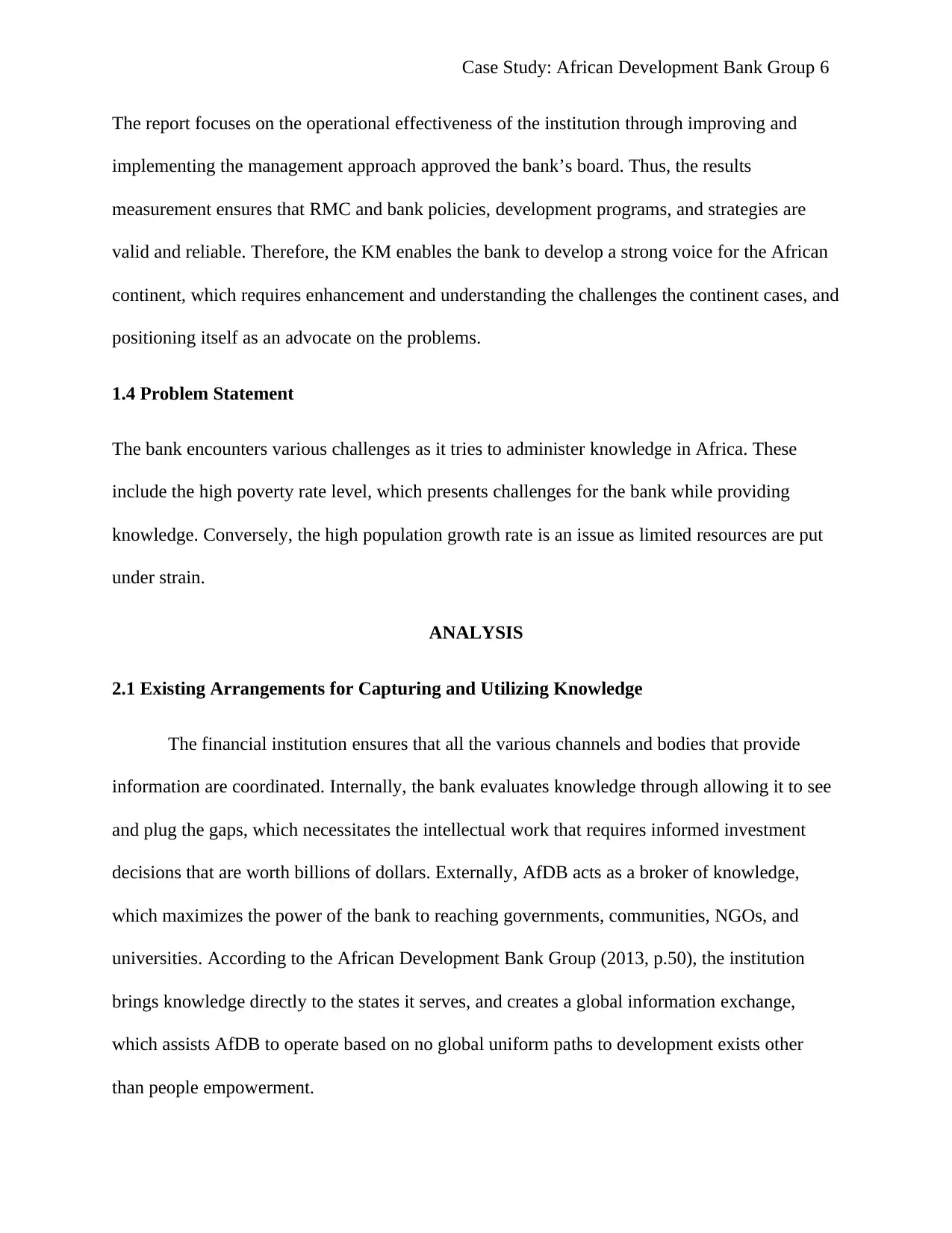
Case Study: African Development Bank Group 6
The report focuses on the operational effectiveness of the institution through improving and
implementing the management approach approved the bank’s board. Thus, the results
measurement ensures that RMC and bank policies, development programs, and strategies are
valid and reliable. Therefore, the KM enables the bank to develop a strong voice for the African
continent, which requires enhancement and understanding the challenges the continent cases, and
positioning itself as an advocate on the problems.
1.4 Problem Statement
The bank encounters various challenges as it tries to administer knowledge in Africa. These
include the high poverty rate level, which presents challenges for the bank while providing
knowledge. Conversely, the high population growth rate is an issue as limited resources are put
under strain.
ANALYSIS
2.1 Existing Arrangements for Capturing and Utilizing Knowledge
The financial institution ensures that all the various channels and bodies that provide
information are coordinated. Internally, the bank evaluates knowledge through allowing it to see
and plug the gaps, which necessitates the intellectual work that requires informed investment
decisions that are worth billions of dollars. Externally, AfDB acts as a broker of knowledge,
which maximizes the power of the bank to reaching governments, communities, NGOs, and
universities. According to the African Development Bank Group (2013, p.50), the institution
brings knowledge directly to the states it serves, and creates a global information exchange,
which assists AfDB to operate based on no global uniform paths to development exists other
than people empowerment.
The report focuses on the operational effectiveness of the institution through improving and
implementing the management approach approved the bank’s board. Thus, the results
measurement ensures that RMC and bank policies, development programs, and strategies are
valid and reliable. Therefore, the KM enables the bank to develop a strong voice for the African
continent, which requires enhancement and understanding the challenges the continent cases, and
positioning itself as an advocate on the problems.
1.4 Problem Statement
The bank encounters various challenges as it tries to administer knowledge in Africa. These
include the high poverty rate level, which presents challenges for the bank while providing
knowledge. Conversely, the high population growth rate is an issue as limited resources are put
under strain.
ANALYSIS
2.1 Existing Arrangements for Capturing and Utilizing Knowledge
The financial institution ensures that all the various channels and bodies that provide
information are coordinated. Internally, the bank evaluates knowledge through allowing it to see
and plug the gaps, which necessitates the intellectual work that requires informed investment
decisions that are worth billions of dollars. Externally, AfDB acts as a broker of knowledge,
which maximizes the power of the bank to reaching governments, communities, NGOs, and
universities. According to the African Development Bank Group (2013, p.50), the institution
brings knowledge directly to the states it serves, and creates a global information exchange,
which assists AfDB to operate based on no global uniform paths to development exists other
than people empowerment.
⊘ This is a preview!⊘
Do you want full access?
Subscribe today to unlock all pages.

Trusted by 1+ million students worldwide
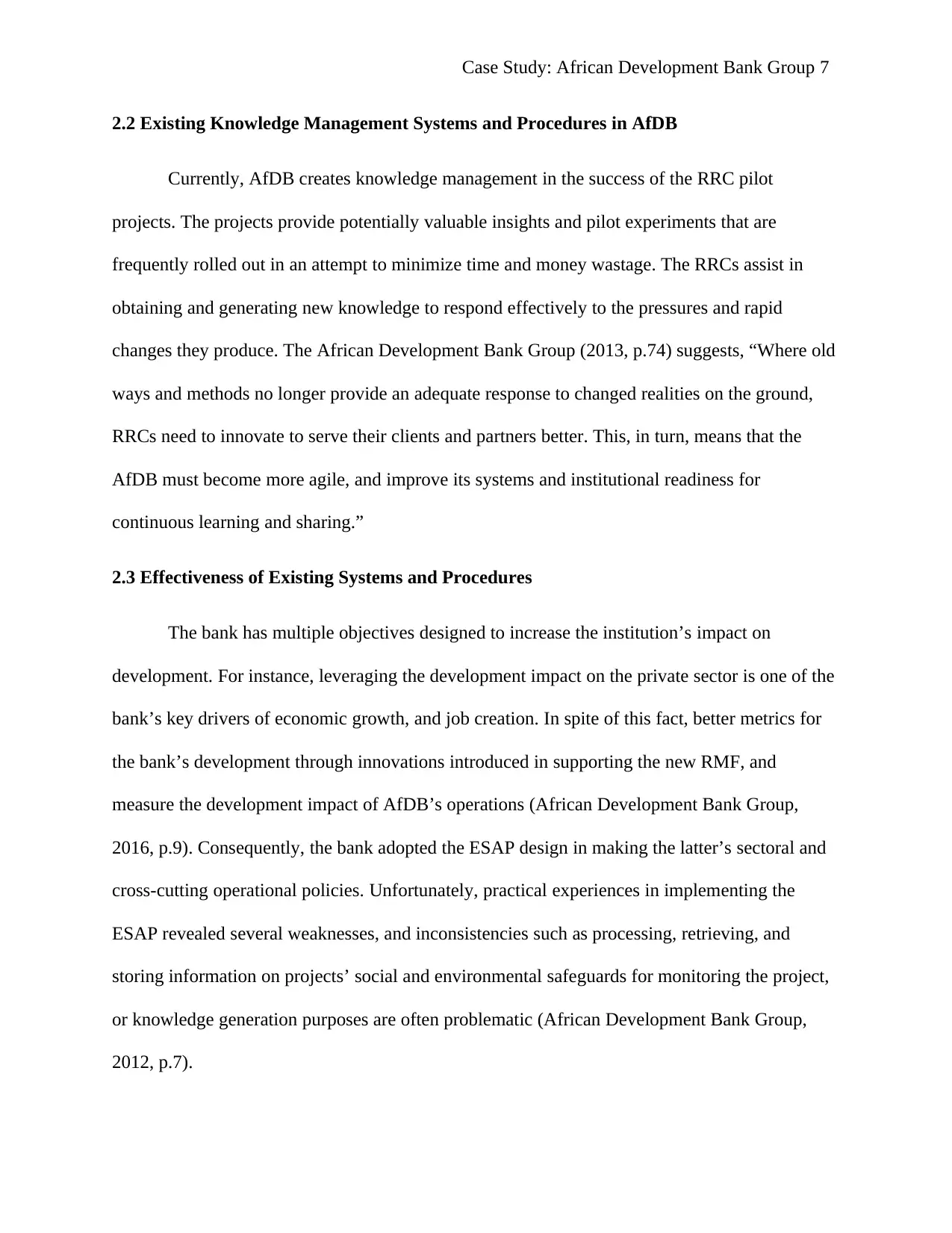
Case Study: African Development Bank Group 7
2.2 Existing Knowledge Management Systems and Procedures in AfDB
Currently, AfDB creates knowledge management in the success of the RRC pilot
projects. The projects provide potentially valuable insights and pilot experiments that are
frequently rolled out in an attempt to minimize time and money wastage. The RRCs assist in
obtaining and generating new knowledge to respond effectively to the pressures and rapid
changes they produce. The African Development Bank Group (2013, p.74) suggests, “Where old
ways and methods no longer provide an adequate response to changed realities on the ground,
RRCs need to innovate to serve their clients and partners better. This, in turn, means that the
AfDB must become more agile, and improve its systems and institutional readiness for
continuous learning and sharing.”
2.3 Effectiveness of Existing Systems and Procedures
The bank has multiple objectives designed to increase the institution’s impact on
development. For instance, leveraging the development impact on the private sector is one of the
bank’s key drivers of economic growth, and job creation. In spite of this fact, better metrics for
the bank’s development through innovations introduced in supporting the new RMF, and
measure the development impact of AfDB’s operations (African Development Bank Group,
2016, p.9). Consequently, the bank adopted the ESAP design in making the latter’s sectoral and
cross-cutting operational policies. Unfortunately, practical experiences in implementing the
ESAP revealed several weaknesses, and inconsistencies such as processing, retrieving, and
storing information on projects’ social and environmental safeguards for monitoring the project,
or knowledge generation purposes are often problematic (African Development Bank Group,
2012, p.7).
2.2 Existing Knowledge Management Systems and Procedures in AfDB
Currently, AfDB creates knowledge management in the success of the RRC pilot
projects. The projects provide potentially valuable insights and pilot experiments that are
frequently rolled out in an attempt to minimize time and money wastage. The RRCs assist in
obtaining and generating new knowledge to respond effectively to the pressures and rapid
changes they produce. The African Development Bank Group (2013, p.74) suggests, “Where old
ways and methods no longer provide an adequate response to changed realities on the ground,
RRCs need to innovate to serve their clients and partners better. This, in turn, means that the
AfDB must become more agile, and improve its systems and institutional readiness for
continuous learning and sharing.”
2.3 Effectiveness of Existing Systems and Procedures
The bank has multiple objectives designed to increase the institution’s impact on
development. For instance, leveraging the development impact on the private sector is one of the
bank’s key drivers of economic growth, and job creation. In spite of this fact, better metrics for
the bank’s development through innovations introduced in supporting the new RMF, and
measure the development impact of AfDB’s operations (African Development Bank Group,
2016, p.9). Consequently, the bank adopted the ESAP design in making the latter’s sectoral and
cross-cutting operational policies. Unfortunately, practical experiences in implementing the
ESAP revealed several weaknesses, and inconsistencies such as processing, retrieving, and
storing information on projects’ social and environmental safeguards for monitoring the project,
or knowledge generation purposes are often problematic (African Development Bank Group,
2012, p.7).
Paraphrase This Document
Need a fresh take? Get an instant paraphrase of this document with our AI Paraphraser
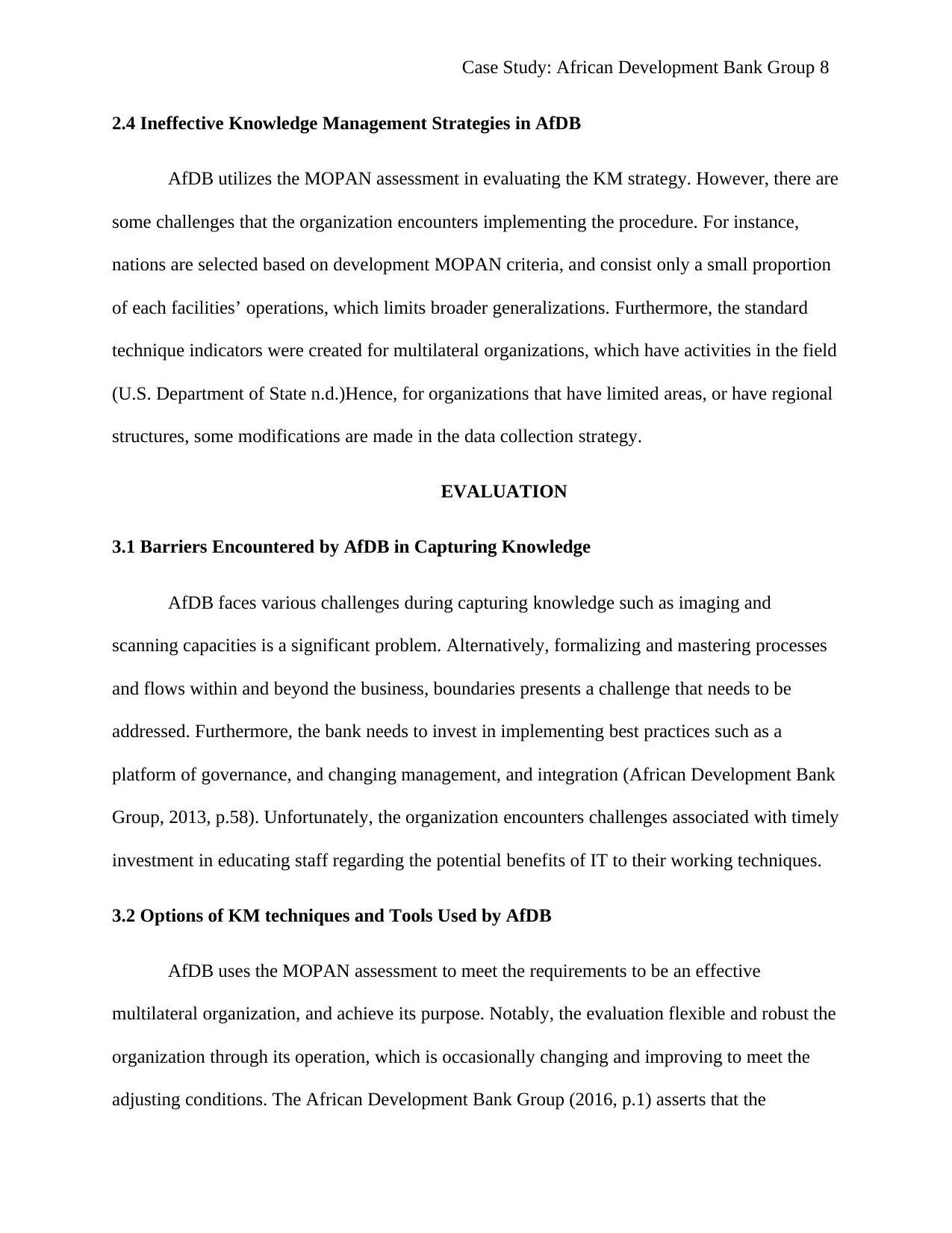
Case Study: African Development Bank Group 8
2.4 Ineffective Knowledge Management Strategies in AfDB
AfDB utilizes the MOPAN assessment in evaluating the KM strategy. However, there are
some challenges that the organization encounters implementing the procedure. For instance,
nations are selected based on development MOPAN criteria, and consist only a small proportion
of each facilities’ operations, which limits broader generalizations. Furthermore, the standard
technique indicators were created for multilateral organizations, which have activities in the field
(U.S. Department of State n.d.)Hence, for organizations that have limited areas, or have regional
structures, some modifications are made in the data collection strategy.
EVALUATION
3.1 Barriers Encountered by AfDB in Capturing Knowledge
AfDB faces various challenges during capturing knowledge such as imaging and
scanning capacities is a significant problem. Alternatively, formalizing and mastering processes
and flows within and beyond the business, boundaries presents a challenge that needs to be
addressed. Furthermore, the bank needs to invest in implementing best practices such as a
platform of governance, and changing management, and integration (African Development Bank
Group, 2013, p.58). Unfortunately, the organization encounters challenges associated with timely
investment in educating staff regarding the potential benefits of IT to their working techniques.
3.2 Options of KM techniques and Tools Used by AfDB
AfDB uses the MOPAN assessment to meet the requirements to be an effective
multilateral organization, and achieve its purpose. Notably, the evaluation flexible and robust the
organization through its operation, which is occasionally changing and improving to meet the
adjusting conditions. The African Development Bank Group (2016, p.1) asserts that the
2.4 Ineffective Knowledge Management Strategies in AfDB
AfDB utilizes the MOPAN assessment in evaluating the KM strategy. However, there are
some challenges that the organization encounters implementing the procedure. For instance,
nations are selected based on development MOPAN criteria, and consist only a small proportion
of each facilities’ operations, which limits broader generalizations. Furthermore, the standard
technique indicators were created for multilateral organizations, which have activities in the field
(U.S. Department of State n.d.)Hence, for organizations that have limited areas, or have regional
structures, some modifications are made in the data collection strategy.
EVALUATION
3.1 Barriers Encountered by AfDB in Capturing Knowledge
AfDB faces various challenges during capturing knowledge such as imaging and
scanning capacities is a significant problem. Alternatively, formalizing and mastering processes
and flows within and beyond the business, boundaries presents a challenge that needs to be
addressed. Furthermore, the bank needs to invest in implementing best practices such as a
platform of governance, and changing management, and integration (African Development Bank
Group, 2013, p.58). Unfortunately, the organization encounters challenges associated with timely
investment in educating staff regarding the potential benefits of IT to their working techniques.
3.2 Options of KM techniques and Tools Used by AfDB
AfDB uses the MOPAN assessment to meet the requirements to be an effective
multilateral organization, and achieve its purpose. Notably, the evaluation flexible and robust the
organization through its operation, which is occasionally changing and improving to meet the
adjusting conditions. The African Development Bank Group (2016, p.1) asserts that the
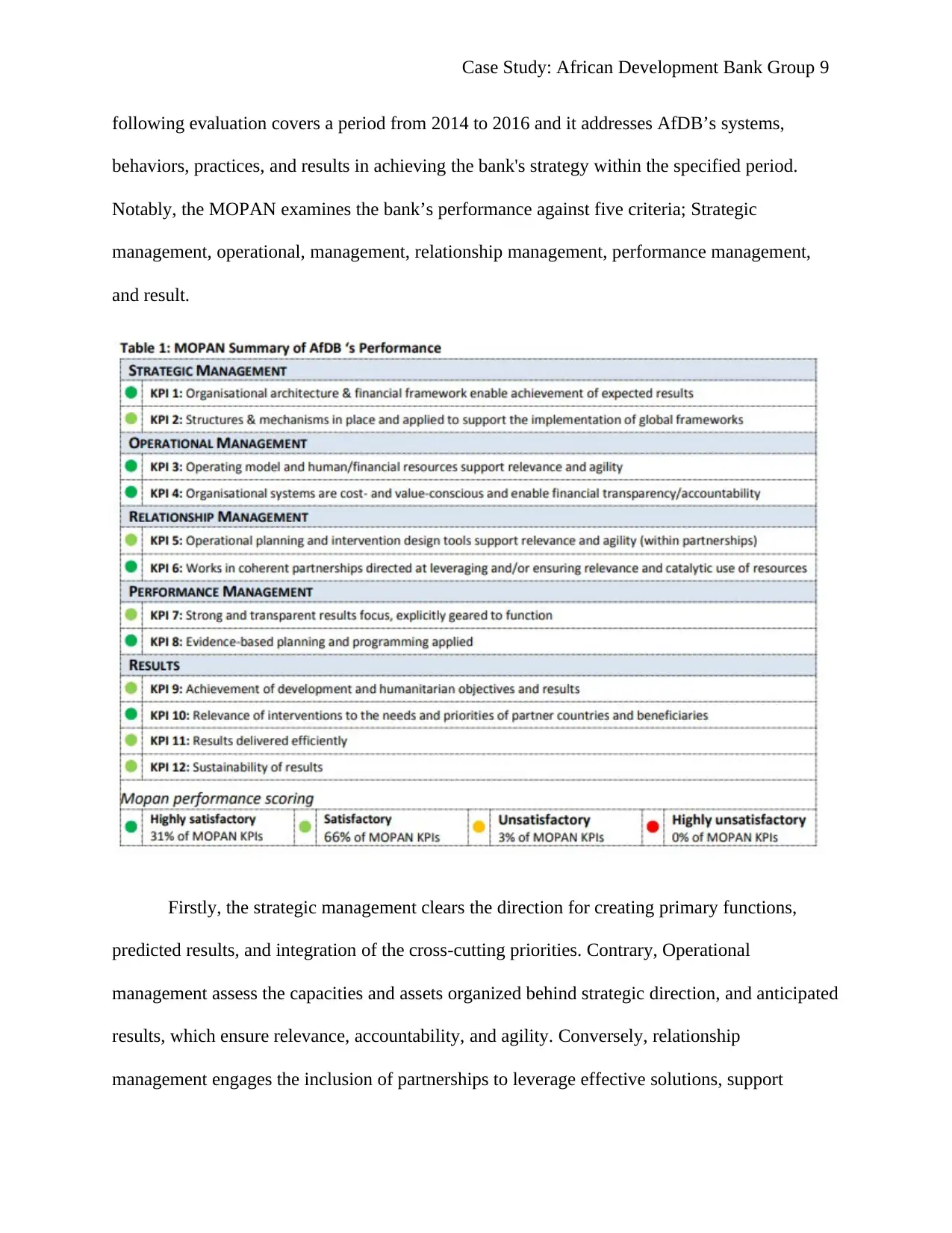
Case Study: African Development Bank Group 9
following evaluation covers a period from 2014 to 2016 and it addresses AfDB’s systems,
behaviors, practices, and results in achieving the bank's strategy within the specified period.
Notably, the MOPAN examines the bank’s performance against five criteria; Strategic
management, operational, management, relationship management, performance management,
and result.
Firstly, the strategic management clears the direction for creating primary functions,
predicted results, and integration of the cross-cutting priorities. Contrary, Operational
management assess the capacities and assets organized behind strategic direction, and anticipated
results, which ensure relevance, accountability, and agility. Conversely, relationship
management engages the inclusion of partnerships to leverage effective solutions, support
following evaluation covers a period from 2014 to 2016 and it addresses AfDB’s systems,
behaviors, practices, and results in achieving the bank's strategy within the specified period.
Notably, the MOPAN examines the bank’s performance against five criteria; Strategic
management, operational, management, relationship management, performance management,
and result.
Firstly, the strategic management clears the direction for creating primary functions,
predicted results, and integration of the cross-cutting priorities. Contrary, Operational
management assess the capacities and assets organized behind strategic direction, and anticipated
results, which ensure relevance, accountability, and agility. Conversely, relationship
management engages the inclusion of partnerships to leverage effective solutions, support
⊘ This is a preview!⊘
Do you want full access?
Subscribe today to unlock all pages.

Trusted by 1+ million students worldwide

Case Study: African Development Bank Group 10
relevance, and maximize results in line with “Busan Partnership” commitments. In contrast,
performance management assesses systems geared to account and manage humanitarian and
development outcomes, and utilizing performance information such as lesson learning and
evaluation. Lastly, results examine the effectiveness of achieving relevant and sustainable
contributions to the development and humanitarian results.
3.3 Evaluation of the Options on AfDB
The strategic management assesses the findings of AfDB and creates a long-term vision,
and reflects carefully on considering comparative advantages that anchor progressive,
transformative approaches for Africa. Thus, the bank introduced the High 5s, which aims at
accelerating the application of ten-year method (from 2013 to 2022), and it has provided a clear
purpose and focuses on the essential transformation of the African continent. Therefore strategic
management assists the bank in achieving the ambitious agenda. Nevertheless, operational
management welcomes the bank’s assessment, which indicates the correctly aligned capacity and
assets to the strategic direction of the institution. Thus, it creates transparency and resource
mobilization that aligns with the ambitions of AfDB.
Relationship management ensures that the bank participates actively in national
processes, which will align its strategies and the regional and country processes and priorities.
The assessment provides a contextual analysis that informs the intervention design to be tailored.
The African Development Bank Group (2016, p.4) mentions that the performance management
assists MOPAN to acknowledge AfDB’s efforts to strengthen its results-oriented to monitor and
evaluate practice, and enhance the use of results-based targets. Finally, the results contain the
bank’s findings using the MOPAN assessment. In addition, the strategic values within partner-
led development are noted with AfDB interventions that contribute to the realization of national
relevance, and maximize results in line with “Busan Partnership” commitments. In contrast,
performance management assesses systems geared to account and manage humanitarian and
development outcomes, and utilizing performance information such as lesson learning and
evaluation. Lastly, results examine the effectiveness of achieving relevant and sustainable
contributions to the development and humanitarian results.
3.3 Evaluation of the Options on AfDB
The strategic management assesses the findings of AfDB and creates a long-term vision,
and reflects carefully on considering comparative advantages that anchor progressive,
transformative approaches for Africa. Thus, the bank introduced the High 5s, which aims at
accelerating the application of ten-year method (from 2013 to 2022), and it has provided a clear
purpose and focuses on the essential transformation of the African continent. Therefore strategic
management assists the bank in achieving the ambitious agenda. Nevertheless, operational
management welcomes the bank’s assessment, which indicates the correctly aligned capacity and
assets to the strategic direction of the institution. Thus, it creates transparency and resource
mobilization that aligns with the ambitions of AfDB.
Relationship management ensures that the bank participates actively in national
processes, which will align its strategies and the regional and country processes and priorities.
The assessment provides a contextual analysis that informs the intervention design to be tailored.
The African Development Bank Group (2016, p.4) mentions that the performance management
assists MOPAN to acknowledge AfDB’s efforts to strengthen its results-oriented to monitor and
evaluate practice, and enhance the use of results-based targets. Finally, the results contain the
bank’s findings using the MOPAN assessment. In addition, the strategic values within partner-
led development are noted with AfDB interventions that contribute to the realization of national
Paraphrase This Document
Need a fresh take? Get an instant paraphrase of this document with our AI Paraphraser
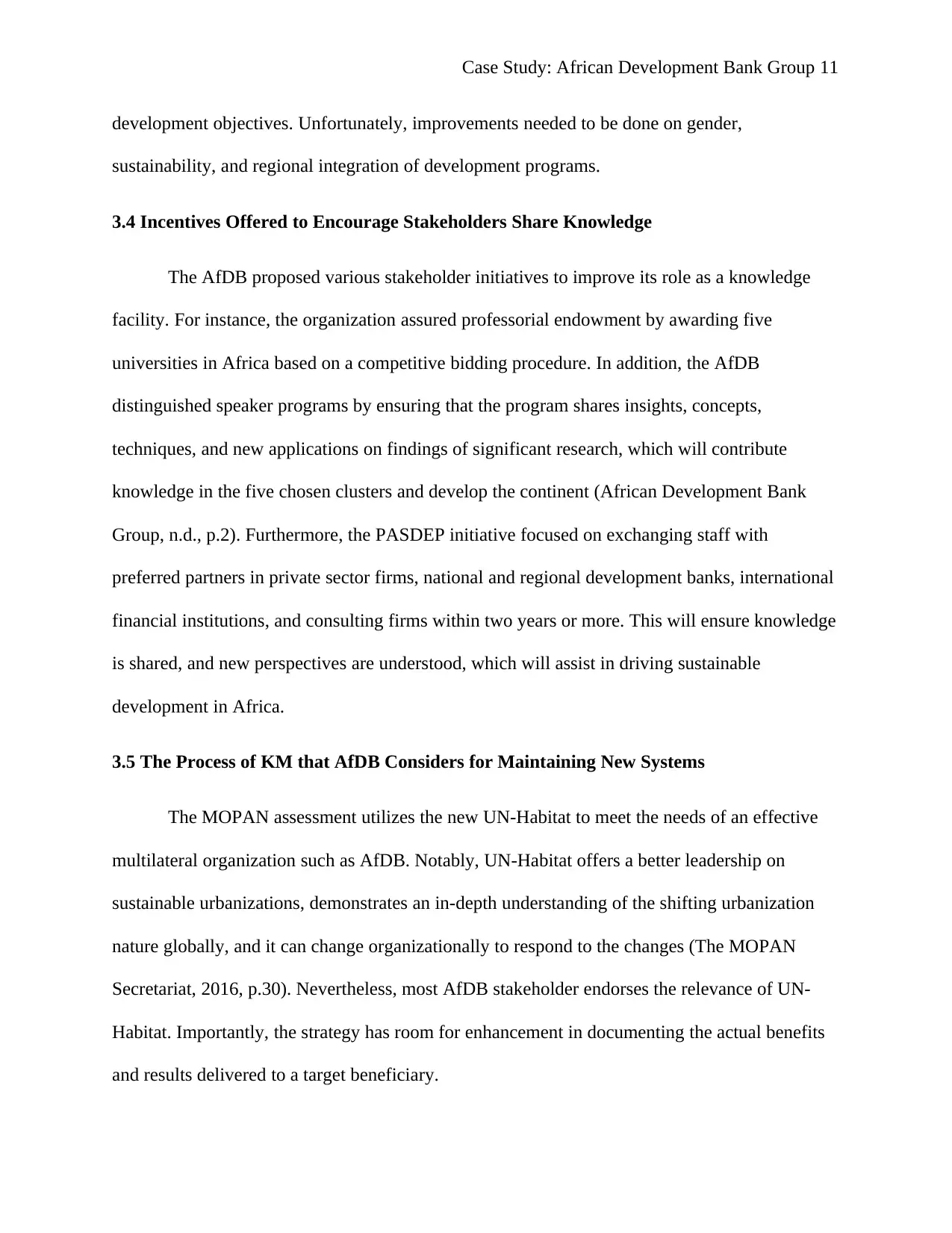
Case Study: African Development Bank Group 11
development objectives. Unfortunately, improvements needed to be done on gender,
sustainability, and regional integration of development programs.
3.4 Incentives Offered to Encourage Stakeholders Share Knowledge
The AfDB proposed various stakeholder initiatives to improve its role as a knowledge
facility. For instance, the organization assured professorial endowment by awarding five
universities in Africa based on a competitive bidding procedure. In addition, the AfDB
distinguished speaker programs by ensuring that the program shares insights, concepts,
techniques, and new applications on findings of significant research, which will contribute
knowledge in the five chosen clusters and develop the continent (African Development Bank
Group, n.d., p.2). Furthermore, the PASDEP initiative focused on exchanging staff with
preferred partners in private sector firms, national and regional development banks, international
financial institutions, and consulting firms within two years or more. This will ensure knowledge
is shared, and new perspectives are understood, which will assist in driving sustainable
development in Africa.
3.5 The Process of KM that AfDB Considers for Maintaining New Systems
The MOPAN assessment utilizes the new UN-Habitat to meet the needs of an effective
multilateral organization such as AfDB. Notably, UN-Habitat offers a better leadership on
sustainable urbanizations, demonstrates an in-depth understanding of the shifting urbanization
nature globally, and it can change organizationally to respond to the changes (The MOPAN
Secretariat, 2016, p.30). Nevertheless, most AfDB stakeholder endorses the relevance of UN-
Habitat. Importantly, the strategy has room for enhancement in documenting the actual benefits
and results delivered to a target beneficiary.
development objectives. Unfortunately, improvements needed to be done on gender,
sustainability, and regional integration of development programs.
3.4 Incentives Offered to Encourage Stakeholders Share Knowledge
The AfDB proposed various stakeholder initiatives to improve its role as a knowledge
facility. For instance, the organization assured professorial endowment by awarding five
universities in Africa based on a competitive bidding procedure. In addition, the AfDB
distinguished speaker programs by ensuring that the program shares insights, concepts,
techniques, and new applications on findings of significant research, which will contribute
knowledge in the five chosen clusters and develop the continent (African Development Bank
Group, n.d., p.2). Furthermore, the PASDEP initiative focused on exchanging staff with
preferred partners in private sector firms, national and regional development banks, international
financial institutions, and consulting firms within two years or more. This will ensure knowledge
is shared, and new perspectives are understood, which will assist in driving sustainable
development in Africa.
3.5 The Process of KM that AfDB Considers for Maintaining New Systems
The MOPAN assessment utilizes the new UN-Habitat to meet the needs of an effective
multilateral organization such as AfDB. Notably, UN-Habitat offers a better leadership on
sustainable urbanizations, demonstrates an in-depth understanding of the shifting urbanization
nature globally, and it can change organizationally to respond to the changes (The MOPAN
Secretariat, 2016, p.30). Nevertheless, most AfDB stakeholder endorses the relevance of UN-
Habitat. Importantly, the strategy has room for enhancement in documenting the actual benefits
and results delivered to a target beneficiary.

Case Study: African Development Bank Group 12
DEVELOPMENT
4.1. Approaches Utilized to Develop KM Strategy
Most of AfDB documents on the environmental and social assessment process for both
private and public sector operations suggest that including public participation results to
consultation (Development Finance International, 2011, p.13). Discussion can be achieved by
sharing information through document dissemination, information seminars, and public
meetings. Furthermore, the organization learns and listening during field visits, consultative
meetings, and interviews. Finally, a joint assessment by the AfDB assists in participatory
evaluation, and beneficiaries’ assessment.
4.2 Effective KM Approach
The MOPAN assessment was utilized to assess the KM approach from 2014 to 2016. The
framework addresses organizational systems, behaviors, and practices of AfDB’s KM technique,
and the results should be relevant for the period 2013 to 2022 strategy (The MOPAN Secretariat,
DEVELOPMENT
4.1. Approaches Utilized to Develop KM Strategy
Most of AfDB documents on the environmental and social assessment process for both
private and public sector operations suggest that including public participation results to
consultation (Development Finance International, 2011, p.13). Discussion can be achieved by
sharing information through document dissemination, information seminars, and public
meetings. Furthermore, the organization learns and listening during field visits, consultative
meetings, and interviews. Finally, a joint assessment by the AfDB assists in participatory
evaluation, and beneficiaries’ assessment.
4.2 Effective KM Approach
The MOPAN assessment was utilized to assess the KM approach from 2014 to 2016. The
framework addresses organizational systems, behaviors, and practices of AfDB’s KM technique,
and the results should be relevant for the period 2013 to 2022 strategy (The MOPAN Secretariat,
⊘ This is a preview!⊘
Do you want full access?
Subscribe today to unlock all pages.

Trusted by 1+ million students worldwide
1 out of 17